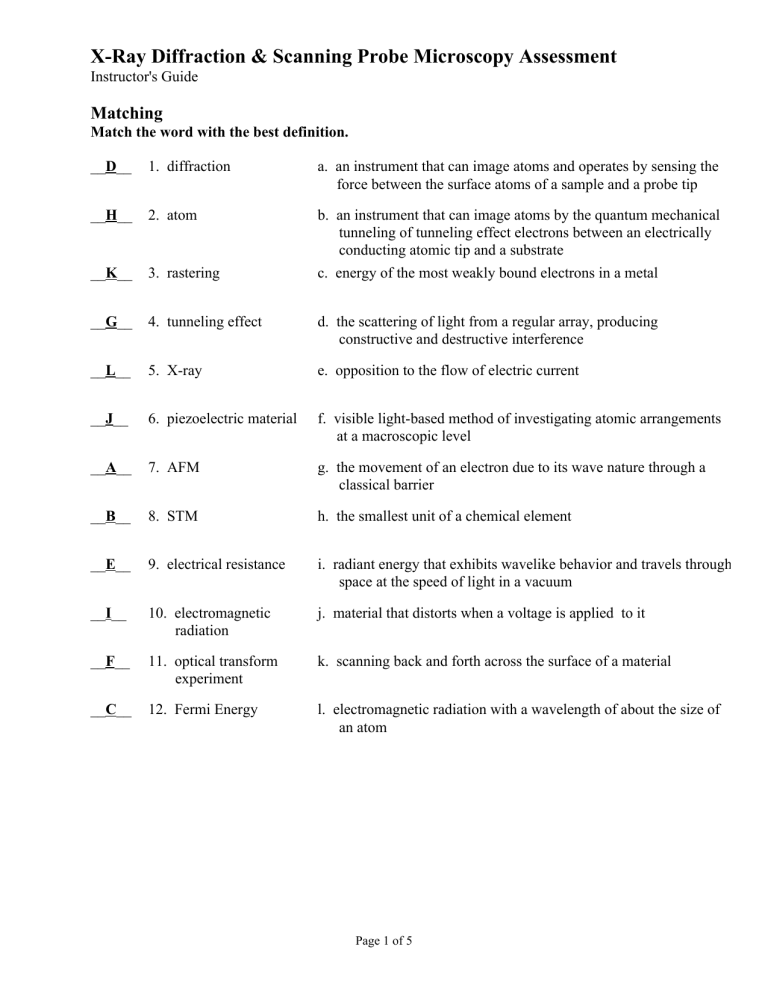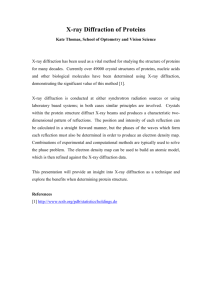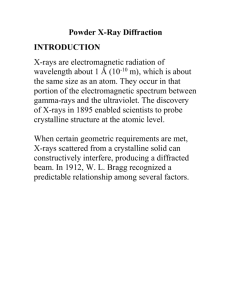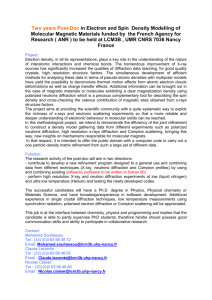Teacher Version

X-Ray Diffraction & Scanning Probe Microscopy Assessment
Instructor's Guide
Matching
Match the word with the best definition.
__D__ 1. diffraction
__H__ 2. atom
__K__ 3. rastering a. an instrument that can image atoms and operates by sensing the force between the surface atoms of a sample and a probe tip b. an instrument that can image atoms by the quantum mechanical tunneling of tunneling effect electrons between an electrically conducting atomic tip and a substrate c. energy of the most weakly bound electrons in a metal
__G__ 4. tunneling effect
__L__ 5. X-ray d. the scattering of light from a regular array, producing constructive and destructive interference e. opposition to the flow of electric current
__J__ 6. piezoelectric material f. visible light-based method of investigating atomic arrangements at a macroscopic level
__A__ 7. AFM g. the movement of an electron due to its wave nature through a classical barrier
__B__ 8. STM h. the smallest unit of a chemical element
__E__ 9. electrical resistance i. radiant energy that exhibits wavelike behavior and travels through space at the speed of light in a vacuum j. material that distorts when a voltage is applied to it __I__ 10. electromagnetic radiation
__F__ 11. optical transform experiment
__C__ 12. Fermi Energy k. scanning back and forth across the surface of a material l. electromagnetic radiation with a wavelength of about the size of an atom
Page 1 of 5
Multiple Choice
Choose the best answer.
__D__ 13. _________ forces act between the electrons and the nuclei of atoms to hold
the atoms of a metal together.
a. Magnetic
c. Intermolecular b. Covalent d. Electrostatic
__B__ 14. The STM uses differences in height or ____ to “map out” the atomic surface.
a. spatial orientation b. electrical current
c. resolution d. light
__D__ 15. Challenges that must be overcome in order to have scanning probe
microscopy work effectively include all of the following EXCEPT
a. vibrations b. probe sharpness
c. position control d. substance is nonconductor of electricity
Problems
16. The radius of a tungsten atom is estimated to be 137 pm. What is the diameter in
meters, centimeters, and angstrom units of a perfect STM tip that terminates in a
single atom of tungsten? SHOW WORK!
The diameter of a tungsten atom is (2)(137 pm) = 274 pm
2.74 x 10
-10
m = 2.74 x 10
-8
cm = 2.74 angstroms
17. How far (in meters) does an STM tip traverse in scanning a row of 400 nickel atoms? The
radius of a nickel atom is 1.24 angstroms. SHOW WORK!
(400 Ni atoms)(2.48 angstroms/Ni atom) = 992 angstroms = 9.92 x 10
-8
m
Page 2 of 5
18. a.) What is the frequency of an X-ray with a wavelength of 1.54 angstroms, the
wavelength produced by an X-ray tube with a copper target? (The speed of light
is 2.998 x 10 8 m/s.) c =
(2.998 x 10 8 m/s) = ( )(1.54 angstroms)(1 x 10 -10 m/ angstrom)
= 1.95 x 10 18 s -1 b.) What is the frequency of an X-ray with a wavelength of 0.7107 angstroms, the
wavelength produced by an X-ray tube with a molybdenum target?
c =
(2.998 x 10
8
m/s) = ( )(0.7107 angstroms)( 1 x 10
-10
m/ angstrom)
= 4.218 x 10 18 s -1
19.
What is the frequency of a 670 nm red laser?
c =
(2.998 x 10 8 m/s) = ( )(670 nm)(1 x 10 -9 m/nm)
= 4.47 x 10 14 s -1
20.
Sketch a qualitative representation of the diffraction pattern produced by the following twodimensional arrays.
a b c . . . . . .
. . . . . .
. . . . . .
. . . . . .
Vertical spots Horizontal spots Square pattern of spots
21.
Sketch a qualitative representation that shows the difference in the diffraction pattern
produced by the following pairs of two-dimensional arrays.
. . . . .
a. . . . . .
. . . . .
. . . . .
. . . . .
. . . . .
. . . . .
. . . . .
The smaller square array gives the larger square diffraction pattern.
b. . . . . .
. . . . .
. . . . .
. . . . .
. . . . .
. . . . .
. . . . .
. . . . .
Page 3 of 5
The pattern on the left gives a square diffraction pattern; the array on the right gives a rectangular diffraction pattern with the long distance between spots in the horizontal direction.
. . . . .
c. . . .
. . .
. . .
. . .
. . .
. . . . .
. . . . .
Both arrays give rectangular diffraction patterns. The array on the left will give a diffraction pattern with the longer edge of the rectangle in the vertical direction.
The array on the right will produce a diffraction pattern with the longer edge of the rectangle in the horizontal direction.
d.
An array of lines gives a series of dots in the diffraction pattern. The horizontal pattern of lines will give a diffraction pattern consisting of a set of spots running in the vertical direction, and the vertical array of lines gives a diffraction pattern consisting of a set of spots in the horizontal direction.
22.
Why must X-rays be used in crystal-structure determinations rather than visible
light?
In order for diffraction to occur, the wavelength of incident radiation must be approximately the same as the spacing of the atoms. Atomic separations are typically a few angstroms. X-rays, with wavelengths of about one angstrom, are a far better match to interatomic spacings than visible light ( ~ 4,000 angstroms to
7,000 angstroms).
23.
Why does X-ray diffraction give more information about the three-dimensional
structure of a crystalline solid than does scanning tunneling microscopy?
The STM can only collect two-dimensional information. The penetrating nature of
X-rays and subsequent diffraction of various planes of atoms adds information in the third dimension.
24.
Use the Bragg equation to explain the observation that as the spacing between the atoms decreases, the spacings in the resulting diffraction pattern increase.
For a given order of diffraction (n value), as d becomes smaller, sin must become larger to satisfy the Bragg equation: 2d(sin ) = n . Thus, as sin and increase, the observed spacing of the spots in a diffraction pattern increases.
Page 4 of 5
25.
Briefly explain how the STM works.
The STM is an instrument that moves a probe tip terminating in a single atom over a surface that is within Angstroms of it. It maps out the contours of the features of the surface, using differences in height at constant current or in electrical current at constant height. Electrostatic forces hold the electrons on the surface of any material, and this acts as a barrier for preventing the electrons from escaping. However, if another material, such as the probe tip is brought close enough to the surface, the electron can escape from the surface into the tip (or vice versa, depending on the direction of the applied voltage) through the quantum mechanical phenomenon of tunneling. A computer typically sends instructions to the tip, and the tip rasters over the surface and creates a complete image of the surface with atomic resolution.
Page 5 of 5







